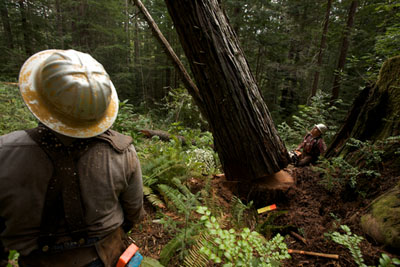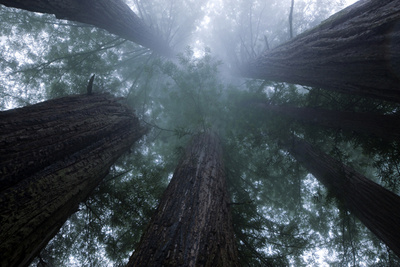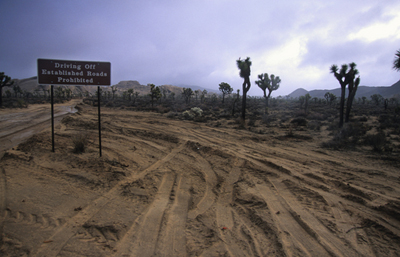
Sustaining forests remains a challenge
Tree populations are declining faster than predicted in multiple national parks due invasive insects, climate change, pollution and human development.
The mass amounts of national parks are covered in forests and some, like Redwood National Park, are known for and named after their tree populations. These forests are considered a natural resources, however since there is demand for focus on other issues in national parks as well as a need to protect them, they are caught in a pull- and-tug of priorities of humans.
| Click on the video at left to view an audio slide show about sustainability of forests in national parks narrated and prepared by writer Katie Guest. |
“Forests are so important to the national parks and need to be preserved for historic, cultural and natural reasons but we run into the problem of invasive species and human development and forests are too big to protect from these. It is really out of our hands until these factors start to kill entire forests or species of trees. We have preventative method plans for diseases and insects but again, our National Park forests are very big and there are many issues we face,” stated Patricia Rily, an administrative assistant for Resource Protection and Visitor Service Branch at Redwood National Park in California.
“It’s a very frustrating issue because there is no easy answer to protect our trees” she added.
Redwood National Park is famous for its large and ancient species of trees. It’s here that disease and invasive insects are effecting the tree populations. With specific trees being of great historical importance due to size and age, there is more focus on trees in this park.
Redwood is probably the only park where this can be found, unfortunately. Other parks, such as Joshua Tree and Great Smoky Mountain, do not have the same funding or priority in the list of issues for park officials.
| Father and son team cutting redwood trees in the Little River tract in California (Photo by Michael Nichols, courtesy of National Geographic). |  |
Joshua Tree National Park in Southern California is starting to see more human development of road building and other activities in recent years and this is affecting the area in which the namesake trees (they are actually a form of cacti) grow.
Similarly to taking an animal’s habitats, when humans invade and take up more space, there is not usually much more space for the wildlife. Since trees also do not evolve nearly as quickly as an animal can, the trees are more likely to die before the populations have time to evolve and move.
Christina Lighter, a recent visitor to Volcanoes National Park, in Hawai’i, she said a damaged or declining forested portion of a park is a disappointment for visitors.
“A lot of people think the forests are fine, but then when you go into the park and there is a big area that is all dead and cleared of trees, you know that’s out of place. Especially in a place like Hawai’i, where our trees and vegetation is everywhere, and is very important to the island and the people that live there, it’s very alarming.”
The death of forested areas in Hawai’i has been found to be caused by the water quality due to pollution in mountain watersheds according to a report by the Forest Service and U.S. agriculture. These forests are extremely unique because of their evolution in complete isolation but this also prevents the situation from dispersing to other trees.
 |
At left, coastal fog covers redwood treetops in the Lady Bird Johnson Grove at Redwood National Park in California (Photo by Michael Nichols, courtesy of National Geographic). Below, new road construction near Hidden Valley Joshua Tree National Park in California (Photo by Bill Hatcher, courtesy of National Geographic). |
A majority of other forests in national parks do not have this same protection.
Great Smoky Mountain Park is very large and all of the forested areas are within close enough range of each other that issues such as the Dutch Elm disease as well as invasive (tree- eating beetles) can spread easily between trees, therefore becoming nearly unstoppable.
So far the best and most controlled protection that has been put in place on forests located inside National Parks is the law against cutting and clearing. Within a national park it is illegal for any person or company to cut down, damage or clear any plot of trees stated by Federal Law enforcements.
“In national forests the motto of production and purpose is ‘The Greatest Amount of Good for the Greatest Amount of people in the long run’” said Chief of Forest Service, Gifford Pinchod.
 National forest allow cutting and clearing as a balance between the use and protection of the trees, but national parks do not allow any trees to be used.
National forest allow cutting and clearing as a balance between the use and protection of the trees, but national parks do not allow any trees to be used.
However, even though national parks trees are not cut, with human development and park use by visitors trees are still damaged and forced to be moved.
Forest declination is the largest spanning issue among the national parks and a very difficult one to solve due to the amount of reasons it is caused.
Invasive species and disease are an issue all on their own not only affecting forests, human development is strictly negotiated through park officials and pollution and climate change are a worldwide problem.
“Park officials at national parks cannot begin to cover the massive land they are asked to protect but with new plans and help from the public they will continue to do their best” stated Joann Cartick, a former parks official.

Comments are Closed